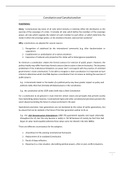DISCLAIMER
MNG3702 assignment 2 (WALMART CASE) semester 1 guide is a product of
internal and external research that includes the study guide, prescribed textbook,
and other authentic sources.
NB: Students must not copy and paste. For clarity, students are free to call on
the provided number and/ email.
MNG3702 0717513144
, MNG3702 0717513144
Question 1
Edward Hall developed the Iceberg analogy of organisational culture in 1976.
By making use of this analogy, explain the organisational culture of Walmart.
In your answer, you need to briefly explain the various layers of organisational
culture, and then apply it to Walmart. (6 marks, of which 1 mark will be
awarded for the correct explanation of each layer of organisational culture and
1 mark for applying it to Walmart for each layer) [6 marks]
According to Venter and Botha (2022), if culture is an iceberg, there are some
aspects which are visible and can be seen (above the water), and a larger aspect
which is hidden beneath the surface (below the water). In a nutshell, the iceberg is
structured in such a way that the tip consists of tangible manifestations that can be
seen and felt, whilst layers underneath become more intangible and less visible,
such as espoused values and norms and taken-for-granted assumptions. Below is a
detailed explanation.
Visible artefacts
Artefacts are those aspects that are everywhere and are visible throughout the
organisation. According to xxx an artefact as ‘an object made by a human being,
typically one of cultural or historical interest’. Thus, artefacts are the most visible and
tangible part of organisational culture and prevail in dress codes, how offices are
decorated as well as their layout, the language used, symbols such as branding
elements ranging from logos to stationery, as well as rituals and myths. These
artefacts can be seen in the name of an organisation, its employees, its products, its
buildings, its processes, as well as in its contracts. Artefacts have three important
dimensions which we need to consider: instrumentality, aesthetics, and symbolism.
The instrumentality of an artefact refers to the extent to which an artefact can help or
hinder organisational performance, such that it considers the efficiency and
effectiveness of structures, processes, procedures, and infrastructure within
organisations. Aesthetics focuses on the look and feel of the artefact and on the
sensory experience it elicits. Symbolism considers the associations or meaning of an
artefact.
MNG3702 0717513144
, MNG3702 0717513144
Case application:
Walmart is the leader of the retail business on a global scale as well as a
multinational retail corporation that operates a chain of hypermarkets (also called
supercenters), discount department stores, and grocery stores. The retail also owns
and operates Sam’s Club retail warehouses. The company’s slogan, “Save money.
Live better,” is also synonymous with the company’s mission. Due to increasing level
of health-consciousness of consumers, Walmart is attempting to increase its range
of organic options and fresh produce. This change is more evident in the US market,
and it is being actively integrated into marketing communication message of the
brand.
Espoused values and norms
This refers to a collection of values and norms shared by people and groups who
work together (Anwar, 2018) . This also includes beliefs and behaviours in the
organisation. These values and norms are often contained in value statements which
outline the organisational values (beliefs and ideas about what kinds of goals the
members of an organisation should pursue) and the appropriate kinds or standards
of behaviour organisational members should use to achieve these goals. Such
values and behaviour have an important influence on strategy formulation and
implementation as they govern how groups of people will respond to envisaged
changes. Organisational culture is tied on the agreed values which comprise beliefs,
traits, and behavioural norms that management has determined should guide the
pursuit of its vision and mission which are explicit and written down in value
statements. It also includes beliefs which reflect someone’s sense of what ought to
be and can typically be discerned in how people talk about issues the organisation
faces. Behaviours are also an important aspect of espoused entailing values day-to-
day ways in which an organisation operates, including work routines, and how the
organisation is structured and controlled. These behaviours may become taken-for-
granted ’ways we do things around here' that are potentially the basis for inimitable
strategic capabilities. However, such behaviours also have the potential to create
significant barriers to achieving strategic change.
MNG3702 0717513144












